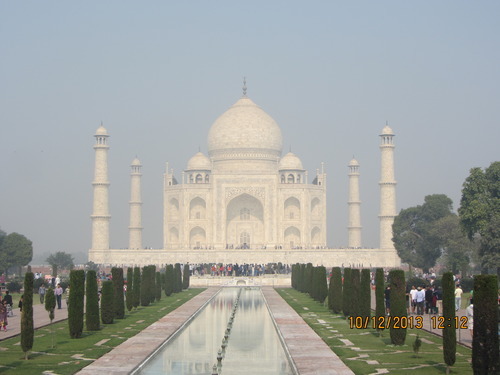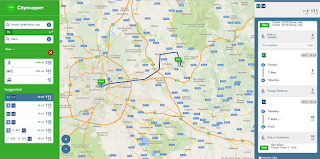Local Transportation
The next step is the local transportation. Most European cities have an excellent public transport network. They also follow an integrated tariff system where the same tickets can be used in all forms of public transportation, from metro to buses and from trams to boats, paying by time from start of your journey, and not distance travelled. So a ticket once validated, permits you to use the transport system for 45-100 minutes, depending on the city. Whether you travel 1 km or 30 km, it will cost you the same.
Tickets. For traveling, you can buy a single ticket or a 'carnet' of 10 tickets, which is generally cheaper. Whenever you get on a bus, find the validating machine and insert the ticket in it. Depending on the system, it will imprint the time physically or electronically. Your time on the transport network starts now. Remember, carrying a ticket, but not validating it, is as good as travelling without a ticket. Checks are not too frequent, but if caught, the fine is hefty. And checking is generally more on the popular tourist routes.
Here are the tickets from Rome and Florence. If you look closely, you can see the date and time imprinted on them.
Here are the tickets from Rome and Florence. If you look closely, you can see the date and time imprinted on them.
The validating machines are placed at the entrance of metros and at the entry doors of the buses. They have an electronic sensor for cards and a slot for inserting paper tickets.
Passes. These cities also have passes which permit you unlimited travel for a given number of days. You need to validate the pass the first time you use it. You can then use any transport as required. Passes are generally good value for money. You just have to find the pass which meets your specific travel requirements.
Finding the Best Route. Various resources are available to help find the best route and combination of transport means to take you from one place to another. The easiest and time-tested method is of course to ask another human. This human can be your landlord, the hotel receptionist or anyone on the street who is a local citizen. For identifying a local, just look for someone who is not carrying a camera, which is a dead giveaway, or aimlessly shuffling around, gawking at every building or statue. Once he/she has directed you to a bus stop, the final confirmation that the bus you have to take will stop there can be done by looking at the information board. All cities in Europe have excellent information boards at each bus stop. It will give you the bus number, the route it will take and the arrival times. In some cities, they also have an electronic board displaying the next bus number and how many minutes it will arrive in. Here are a few examples, from Rome and Venice.
However, if you detest speaking to the uncivilized locals, who may not even know english, or if asking for directions is just beneath you or you simply consider technology to be the answer to all problems, you may find the following resources useful :-
However, if you detest speaking to the uncivilized locals, who may not even know english, or if asking for directions is just beneath you or you simply consider technology to be the answer to all problems, you may find the following resources useful :-
- Websites
- Google Maps - Most transport companies share data with them. So a search for directions on google maps will include public transport options, including buses, trains, trams and their combinations. The results are shown with the exact timings of the bus, helping you decide when you should leave your hotel, or how much time you have to wander around before moving to the bus stand. However, this information is not available offline. This is one major reason why having a smartphone with an active data connection is very useful.
- Here Maps - Formerly Nokia Maps. The information it provides is very similar to Google Maps. Though, it has the advantage that you can download maps by country / city for offline use, you still need a data connection for public transportation options.
- Hopstop - This site is another option for online local transit directions.
- Many city transport authorities also have their own website/ apps. Check them out for the cities you are visiting, using google search. Since the english versions of these websites are generally not easy to understand, you may need the help of Google Translate. Some of these websites are - ATAC (Rome), ATAF (Florence), ACTV (Venice), Wiener Linien (Vienna) and RATP (Paris).
- Apps
- CityMapper (Android and iOS) - Presently available for 28 cities around the world - and growing. It has maps, public transportation schedules, timings, etc - and all available offline. So you can download the data for the city you are visiting and you are good to go. Data connection is required if you want info on real-time delays, etc. They also have a web version.
- Transit (Android and iOS) - Similar to Citymapper. It has a much larger worldwide coverage.
- Moovit (Android and iOS) - Covers over 600 cities. Unlike Citymapper and Transit, this app uses crowdsourced data, like Waze, to give you information on public transportation.
Conclusion
Planning your local movements, and also having the tools to plan it on the move, can save you a great deal of time, money and headache. One missed bus, leading to an hour waiting in the most uninteresting corner of town, is the surest way to ruin the rest of the day. You need not plan every move across town. But be sure to check the time and frequency of buses when going to the outskirts or a nearby town. You can also check the most comfortable means of traveling when the journey time is likely to be long.
However, speed and comfort need not be the only factors while deciding how you get around town. In Paris, for instance, the metro is an extremely efficient and fast means of transport. However, if you spend all your travel time underground, you will be missing out on a large part of this beautiful city. So be sure to use the bus, or even a bicycle when possible, to watch the city as it goes by.
In the end, walking is the best way to get around most European cities. You may use the public transport to reach the city centre, but thereafter plan to walk from one place to another.
You need to slow down to truly enjoy the experience.
**********************************************************************************
Other posts in this series......
Eurotrip 2015 - Our Grand Tour
Eurotrip 2015 Episode 1- Genesis
Plan a European Holiday in 5 Easy Steps
How to Fly to Europe on a Budget
Hassle-free Bookings to Stay Within Budget
Planes, Trains and Automobiles - How to Travel Across Europe on the Cheap
Low Cost Airlines in Europe : A Budget Travelers Guide
Places to Visit - A Guide to Creating your Own Local Itinerary
Visa - The Key to the Beckoning Gates
Golden Tickets, Magic Passes and Hidden Entrances
You need to slow down to truly enjoy the experience.
**********************************************************************************
Other posts in this series......
Eurotrip 2015 - Our Grand Tour
Eurotrip 2015 Episode 1- Genesis
Plan a European Holiday in 5 Easy Steps
How to Fly to Europe on a Budget
Hassle-free Bookings to Stay Within Budget
Planes, Trains and Automobiles - How to Travel Across Europe on the Cheap
Low Cost Airlines in Europe : A Budget Travelers Guide
Places to Visit - A Guide to Creating your Own Local Itinerary
Visa - The Key to the Beckoning Gates
Golden Tickets, Magic Passes and Hidden Entrances


































